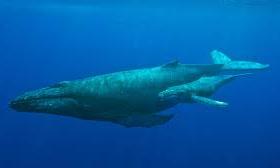
Unique humpback whale "fingerprint" tracked by scientists
text_fieldsIn Antarctica, scientists eagerly await the appearance of two humpback whales, aiming to capture a photographic "fingerprint" of their tails to aid in identifying individual whales.
Andrea Bonilla, a Colombian scientist from Cornell University, has been collaborating with a research team since 2014 to document humpback whales through visual analysis of their tails, known as flukes.
"What we are doing is tracking the history of each individual," Bonilla explained while aboard the ARC Simon Bolivar during a scientific expedition by the Colombian navy, reported AFP.
Over the years, the team has identified 70 whales and anticipates observing them again to document any physical changes that may offer insights into their migration patterns, population sizes, health, and sexual maturity.
Bonilla elaborated on the uniqueness of the tail markings, likening them to fingerprints: "The coloration and patterns that each whale has is unique, it is like a fingerprint, so what we do is look at the different marks they have, the different scars, to identify an individual."
Although global populations of humpback whales have recovered following the devastating impact of commercial whaling, they continue to face threats such as vessel strikes, illegal fishing, pollution, and underwater noise. The International Union for Conservation of Nature estimates that there are around 84,000 adult humpback whales worldwide.
A recent study published in the Royal Society Open Science journal emphasized the importance of tail identification, revealing a 20% decline in the number of humpback whales in the North Pacific in less than a decade, possibly due to starvation caused by marine heat waves.
The technique of photo identification, particularly focusing on flukes, is prevalent in marine mammal research, especially with humpbacks due to their distinctive markings and tail-raising behavior while diving.
Humpback whales migrate between warm breeding spots and polar feeding grounds across different regions of the world's oceans. Bonilla explained how they capitalize on the abundant food sources in Antarctica to accumulate energy over several months.
By closely examining photographs of whale flukes, scientists can glean information about attacks from other animals, potential skin diseases, or dietary habits. This inventory enables the tracking of specific whales, critical for conservation efforts.
Bonilla emphasized the significance of protecting areas where whales frequent for breeding, stating, "If a whale always comes to the same area to reproduce, it is important to protect those areas. If they cease to exist or are disturbed, that whale will have nowhere to go."























